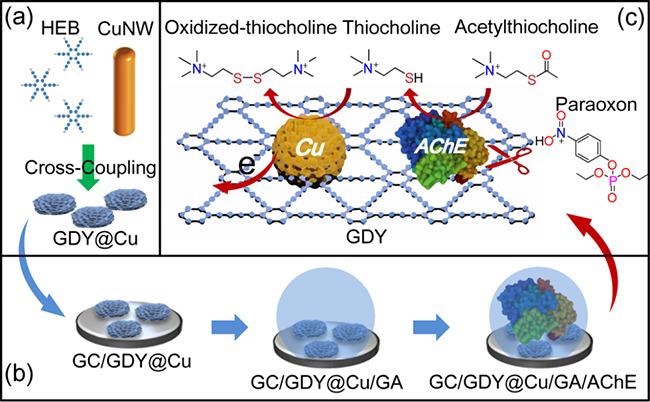A class of lethal nerve agents, known as organophosphorus pesticides (Ops), commonly used in agriculture is a dangerous threat to the wellbeing of humans and their environment.
 Schematic illustrations of the biosensor fabrication and OPs detection. Image Credit: Kai Nui.
Schematic illustrations of the biosensor fabrication and OPs detection. Image Credit: Kai Nui.
Electrochemical biosensors — based on the acetylcholinesterase (AChE) inhibition — has been considered the perfect tool for OPs’ fast detection. However, the biosensor suffers from slow electrode kinetics and high oxidation capacity toward signal species.
For the interference-free detection of OPs, a research team — headed by Prof. Xianbo Lu and Prof. Jiping Chen from the Dalian Institute of Chemical Physics (DICP) of the Chinese Academy of Sciences (CAS) — has designed a high-performance electrochemical biosensor.
This study was published on February 21st, 2022, in the Biosensors and Bioelectronics journal.
The team created a nanocomposite of ultrafine Cu quantum dots (QD) that are evenly loaded on 3D ultrathin graphdiyne (GDY) nanosheets (also denoted as Cu@GDY) through a one-step strategy. Cu@GDY exhibited a high density of active sites with consistent stability.
Furthermore, the researchers made an AChE biosensor depending on Cu@GDY to identify OPs and established that the findings of the Cu@GDY nanocomposite could enhance the electrochemical signal and decrease the OPs’ oxidation potential.
In addition, the possible electro-catalysis mechanism and structure-activity relationships of the proposed biosensor via defining the electrode reaction kinetics, the active sites source, and the signal species–active site interaction were examined by the researchers.
After theoretical derivation and experimental verification of enzyme inhibition kinetics, the biosensor was verified to have high sensitivity to detect OPs.
Xianbo Lu, Professor, Dalian Institute of Chemical Physics, Chinese Academy of Sciences
The National Natural Science Foundation of China and the Dalian Science and Technology Innovation Fund supported this study.
Journal Reference:
Niu, et al. (2022) Ultrathin graphdiyne nanosheets confining Cu quantum dots as robust electrocatalyst for biosensing featuring remarkably enhanced activity and stability. Biosensors and Bioelectronics. doi.org/10.1016/j.bios.2022.114111.